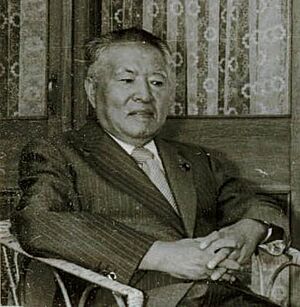Kenji Miyamoto (politician) facts for kids
Quick facts for kids
Kenji Miyamoto
|
|
|---|---|
| 宮本 顕治 | |

Miyamoto in 1978
|
|
| Chairman of the Central Committee of the Japanese Communist Party | |
| In office 31 July 1982 – 26 September 1992 |
|
| Preceded by | Sanzō Nosaka |
| Succeeded by | Tetsuzo Fuwa (2000) |
| Chairman of the Japanese Communist Party | |
| In office 7 July 1970 – 31 July 1982 |
|
| Preceded by | Himself (as General Secretary) |
| Succeeded by | Tetsuzo Fuwa |
| General Secretary of the Japanese Communist Party | |
| In office 1 August 1958 – 7 July 1970 |
|
| Preceded by | Sanzo Nosaka |
| Succeeded by | Himself (as Chairman) |
| Member of House of Councillors | |
| In office 11 July 1977 – 9 July 1989 |
|
| Constituency | National district (1977-1983) National PR block (1983-1989) |
| Personal details | |
| Born | 17 October 1908 Hikari, Yamaguchi, Empire of Japan |
| Died | 18 July 2007 (aged 98) Tokyo, Japan |
| Political party | Japanese Communist Party |
| Alma mater | Tokyo Imperial University |
Kenji Miyamoto (宮本 顕治, Miyamoto Kenji, 17 October 1908 – 18 July 2007) was an important Japanese politician. He was a leader of the Japanese Communist Party (JCP) for many years. He helped shape the party's direction from 1958 to 1977.
Contents
Kenji Miyamoto's Early Life
Kenji Miyamoto was born in 1908 in a place called Shimata-mura, in Yamaguchi Prefecture, Japan. He went to Tokyo Imperial University, which is now the University of Tokyo. He studied economics there and graduated in March 1931.
Joining the Japanese Communist Party
Kenji Miyamoto officially joined the Japanese Communist Party (JCP) in May 1931. This was just two months after he finished university. In 1932, Miyamoto married Yuriko Chūjō. She was an author and helped people. Yuriko was also a member of the JCP.
At that time, the JCP was not allowed by the government. The government tried to stop its activities. In 1933, Miyamoto was arrested by the Japanese military police. He was accused of a serious crime. Miyamoto said he did not do it. He was found guilty and sent to prison for life.
He stayed in prison for 12 years. He was released in 1945 when World War II ended. Japan surrendered, and an order from the Emperor freed him.
Leading the Japanese Communist Party
After being released from prison, Miyamoto quickly returned to politics. He became involved with the JCP again. He led the party's election campaign in 1949. The JCP won 35 seats in the election that year.
However, the JCP lost support in 1950. This was just before the Korean War started. A powerful American general, Douglas MacArthur, banned Miyamoto and 23 other top JCP members from holding public office.
Miyamoto became the head of the JCP in 1958. That same year, he changed his mind about something important. He had previously called for a violent revolution in Japan. Now, he said the JCP would take a peaceful path. He called this new approach "smiling communism."
Under Miyamoto's leadership, the party focused on everyday issues. These included housing, rising prices, and education. He made the JCP more mainstream. In 1976, he removed a phrase about "proletarian dictatorship" from the party's goals. Instead, the JCP declared its support for democracy and freedom. The party still follows this platform today.
The JCP grew stronger under Miyamoto. This happened even though many Japanese people did not like the party's views on the Japanese Imperial Family. In 1979, the JCP reached its highest point in elections. It won 8% of the seats in Japan's lower house of Parliament, the House of Representatives.
Miyamoto was known for having his own strong opinions. In 1966, he visited China and said their "Cultural Revolution" was "abnormal." He also strongly spoke out against the Soviet Union's invasion of Czechoslovakia in 1968. Miyamoto did not like the close friendship between Japan and the United States. When communism fell in eastern Europe in 1989, Miyamoto said it was a defeat for Stalinism and Soviet-backed governments, but not for socialism itself.
Miyamoto stepped down as the main leader of the JCP in 1977. Tetsuzo Fuwa took over as chairman in 1982. Miyamoto remained active in the JCP. He continued to hold the post of chairman until he officially retired in September 1997. From 1997 until his death, he held an honorary position in the party.
Later Life and Death
Kenji Miyamoto died on July 18, 2007, in a Tokyo hospital. He was 98 years old. He died from a lung condition called emphysema. His wife, Yuriko Miyamoto, had passed away earlier in 1951.
See also
 In Spanish: Kenji Miyamoto para niños
In Spanish: Kenji Miyamoto para niños
- Japanese dissidence during the Shōwa period

